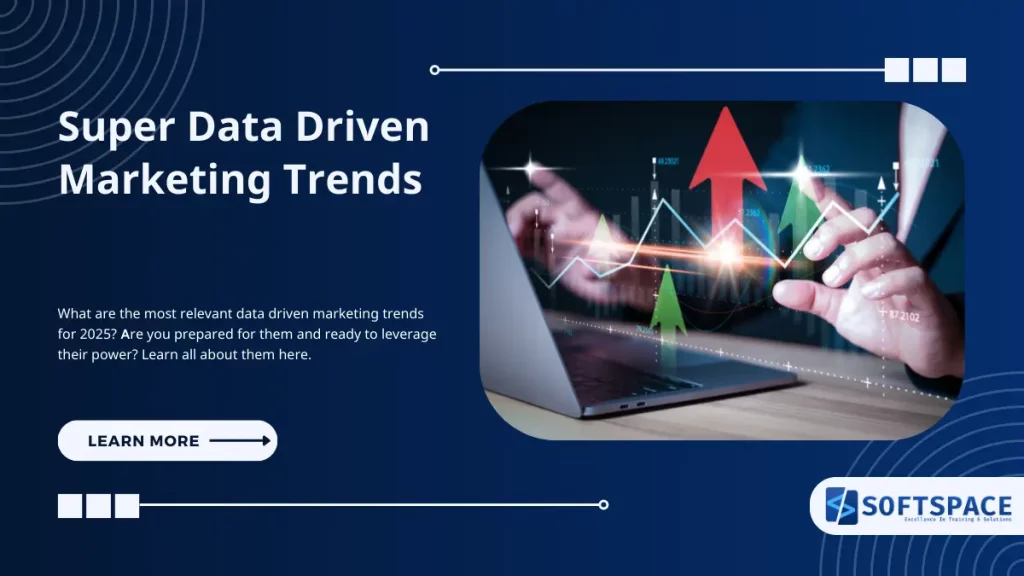Think about how your grandparents used to run their business. A firm handshake, a gut feeling about what customers wanted, and maybe a notebook full of loyal customers’ preferences. Pretty simple, right?
Now look at your phone. Every time you scroll, tap, or swipe, you’re leaving digital breadcrumbs that tell a story about who you are and what you might want to buy next. As a marketer in 2025, it’s like having a superpower – but sometimes it feels more like drinking from a fire hose!
Here’s the thing: we’re not just playing with spreadsheets anymore. Those mysterious algorithms everyone talks about? They’re working around the clock, learning from every customer interaction, helping brands understand us better than we sometimes understand ourselves. It’s both exciting and a little mind-boggling.
But here’s the kicker – having all this information doesn’t automatically make you a marketing genius. It’s like having the world’s best kitchen with all the fancy gadgets, but still needing to know how to cook. The real magic happens when you can turn all those numbers and trends into something that actually connects with real people.
For those of us in marketing, it’s time to embrace our inner tech geek with data driven marketing trends while keeping our human touch. The tools are changing, sure, but the heart of marketing remains the same: understanding people and telling stories that resonate.
Whether you’re a CMO in a corner office or running campaigns from your home office, the game has changed. But don’t panic – think of it as upgrading from a paper map to GPS. Same destination, just better tools to get there.
The future belongs to those who can blend the art of marketing and follow the data driven marketing trends. And trust me, it’s a lot more fun than it sounds!

What is Data Driven Marketing?
Data-driven marketing is a strategic approach that uses customer data and analytics to inform marketing decisions and strategies. Think of it as making marketing choices based on concrete evidence rather than gut feeling or assumptions. Here’s a detailed breakdown:
Core Elements of Data Driven Marketing:
- Data Collection
- Customer demographics and behaviours
- Purchase history and patterns
- Website interactions and engagement metrics
- Social media activity
- Email campaign performance
- Customer service interactions
- Key Components:
- Customer segmentation based on actual behaviour
- Performance measurement using precise metrics
- Personalised messaging and targeting
- Campaign optimization using real-time insights
- ROI tracking and attribution
Benefits:
- More efficient budget allocation
- Better understanding of customer needs
- Higher conversion rates
- Improved customer experience
- Measurable results
- Reduced marketing waste
Real-world example: Instead of sending the same email to all customers, a clothing retailer might:
- Analyse past purchase data
- Identify customers who buy winter coats in autumn
- Track their browsing patterns
- Send personalised offers for coats just before the season starts
- Measure response rates and adjust timing/messaging accordingly
The Super Data Driven Marketing Trends for 2025
1. AI-Powered Hyper-Personalisation
The evolution of AI-driven personalisation is revolutionising how brands connect with consumers. Unlike traditional segmentation, this approach leverages deep learning algorithms to analyse thousands of data points in real-time, creating truly individualised experiences.
Marketing messages, product recommendations, and even pricing strategies adapt dynamically based on a comprehensive understanding of each customer’s behaviour, preferences, and context.
Organisations are increasingly employing natural language processing and computer vision to understand customer interactions across text, voice, and visual touchpoints, enabling unprecedented levels of personalisation that feel natural rather than intrusive.
2. Privacy-First Analytics
As public awareness of data privacy grows and regulations tighten, organisations are fundamentally reimagining their analytics strategies. Privacy-first analytics emphasises collecting and utilising data whilst respecting user privacy through innovative approaches like edge computing and differential privacy.
Companies are investing heavily in first-party data infrastructure, developing transparent data collection mechanisms, and implementing privacy-preserving machine learning techniques.
This shift isn’t just about compliance—it’s about building trust through ethical data practices whilst maintaining analytical capabilities. Zero-party data, voluntarily shared by customers, is becoming increasingly valuable.
3. Predictive Customer Lifetime Value (PCLV)
PCLV analytics is transforming how organisations prioritise and nurture customer relationships. Advanced machine learning models now consider hundreds of variables to forecast a customer’s potential future value with remarkable accuracy.
These predictions extend beyond simple purchase history to incorporate behavioural patterns, engagement metrics, and external factors. Marketing teams are using PCLV scores to optimise resource allocation, personalise retention strategies, and identify high-potential customers early in their journey.
This approach enables proactive relationship management and more efficient marketing spending.
4. Cross-Platform Data Unification
The complexity of modern customer journeys demands sophisticated data unification strategies. Customer Data Platforms (CDPs) are evolving to handle real-time data synchronisation across dozens of touchpoints, creating a genuine single customer view.
This unified approach enables organisations to deliver consistent experiences whether a customer is browsing on mobile, speaking with customer service, or shopping in-store. Advanced identity resolution techniques ensure accurate customer recognition across devices and channels, whilst real-time data activation enables immediate response to customer behaviour.
5. Voice Search and Conversational Analytics
Voice interaction is rapidly becoming a primary interface for consumer-brand interactions. Sophisticated natural language processing algorithms are enabling brands to understand not just what customers are saying, but their intent and emotional state. Marketing strategies are adapting to optimise for voice search patterns, which differ significantly from text-based queries.
Analytics platforms are evolving to capture and analyse conversational data, providing insights into customer preferences, pain points, and decision-making processes. Voice commerce is seeing particular growth in routine purchases and service interactions.
6. Automated Decision Intelligence
Decision intelligence platforms are revolutionising marketing resource allocation through sophisticated AI algorithms. These systems analyse vast amounts of data to make real-time decisions about campaign optimisation, budget allocation, and content distribution.
Machine learning models continuously learn from outcomes, improving their decision-making capabilities over time. This automation extends beyond simple A/B testing to complex, multi-variable optimisation across entire marketing ecosystems.
Marketers are freed to focus on strategy whilst AI handles tactical optimisation.
7. Emotional Analytics and Sentiment Analysis
Understanding customer emotions is becoming increasingly sophisticated through advanced sentiment analysis. AI systems now analyse text, voice, facial expressions, and even biometric data to gauge emotional responses to marketing initiatives.
This deeper understanding enables brands to craft more empathetic and effective communications. Real-time sentiment tracking across social media, customer service interactions, and review platforms allows immediate response to negative sentiment and capitalisation on positive momentum.
The focus is shifting from simple positive/negative classification to nuanced emotional understanding.
8. Augmented Reality Data Integration
AR is evolving from a novelty to a serious marketing tool, generating valuable data about customer preferences and behaviour. Brands are integrating AR experiences into their marketing strategies, collecting data on how customers interact with virtual products in their real environments.
This data provides unprecedented insights into customer decision-making processes during the consideration phase. Analytics platforms are developing specialized capabilities to process and analyse AR interaction data, enabling brands to optimise both virtual and physical customer experiences.
9. Blockchain for Marketing Data
Blockchain technology is bringing unprecedented transparency and trust to marketing data management. Decentralised ledgers are being used to verify data authenticity, track consumer consent, and enable secure data sharing between partners.
Smart contracts automate compliance with data usage agreements, whilst blockchain-based loyalty programmes create verifiable customer rewards systems.
This technology is particularly valuable in combating ad fraud and ensuring the authenticity of customer reviews, creating a more trustworthy marketing ecosystem.
10. Real-Time Intent Modeling
Intent modelling has evolved to predict customer needs and desires in real-time, enabling truly proactive marketing. Advanced algorithms analyse browsing patterns, search behaviour, and interaction data to understand customer intent at each moment.
This understanding enables dynamic content adaptation and next-best-action recommendations that feel helpful rather than intrusive. Marketing automation systems are becoming increasingly sophisticated at triggering relevant actions based on predicted intent, creating more natural and effective customer journeys.
Applications of Data Driven Marketing Trends
Data driven marketing trends are reshaping how businesses connect with their audiences. By leveraging insights from advanced analytics, AI, and real-time data, brands can craft personalised experiences, optimise strategies, and predict future consumer behaviours.
These trends enable companies to stay competitive, foster stronger customer relationships, and adapt to changing market dynamics with precision. In today’s fast-paced digital world, applying these trends is essential for driving growth and achieving impactful marketing results. Check the following trends for example:
Strategic Customer Acquisition
- Advanced Lead Scoring
- Implement behaviour-based scoring systems that track potential customers across multiple touchpoints
- Analyse website interaction patterns to identify serious buyers
- Score leads based on demographic fit, engagement level, and purchase intent signals
- Automatically prioritise high-potential prospects for sales follow-up
- Targeted Advertising Optimisation
- Create lookalike audiences based on your best customers’ profiles
- Adjust bid strategies in real-time based on performance data
- Test multiple creative variations across different audience segments
- Track cross-channel attribution to optimise ad spend
Customer Retention and Loyalty Enhancement
- Predictive Churn Prevention
- Identify early warning signs of customer dissatisfaction
- Monitor engagement patterns to spot declining interest
- Deploy automated re-engagement campaigns at crucial moments
- Personalise retention offers based on customer value and history
- Loyalty Programme Optimisation
- Analyse reward redemption patterns to improve programme structure
- Personalise rewards based on individual customer preferences
- Track programme ROI across different customer segments
- Adjust benefits based on customer lifetime value predictions
Revenue Growth Strategies
- Dynamic Pricing Implementation
- Adjust prices in real-time based on demand, competition, and inventory levels
- Analyse price sensitivity across different customer segments
- Test different pricing strategies for new products
- Optimise promotional pricing for maximum revenue impact
- Cross-Selling and Upselling
- Identify product affinity patterns
- Create personalised bundle recommendations
- Time upgrade offers based on usage patterns
- Track success rates across different customer segments
Campaign Performance Optimization
- Advanced A/B Testing
- Test multiple variables simultaneously
- Analyse results across different customer segments
- Implement automated winner selection
- Scale successful variations quickly
- Real-Time Optimisation
- Monitor campaign performance metrics continuously
- Adjust targeting parameters on the fly
- Reallocate budget to top-performing channels
- Modify messaging based on response data
Customer Experience Enhancement
- Journey Mapping and Analysis
- Track customer interactions across all touchpoints
- Identify pain points and drop-off locations
- Analyse successful journey patterns
- Implement improvements based on data insights
- Personalisation at Scale
- Deliver customised content based on behaviour patterns
- Adjust website experience for different visitor segments
- Personalise email content and timing
- Tailor product recommendations in real-time
Market Intelligence and Planning
- Competitive Analysis
- Track competitor pricing and promotion strategies
- Analyse market share trends
- Monitor customer sentiment across brands
- Identify emerging market opportunities
- Trend Prediction
- Analyse historical data patterns
- Monitor social media trends
- Track seasonal variations
- Predict emerging customer needs
Implementation Framework
- Infrastructure Requirements
- Robust data collection systems
- Advanced analytics capabilities
- Integration across platforms
- Secure data storage solutions
- Team Capabilities
- Data analysis skills
- Technical expertise
- Marketing strategy knowledge
- Customer insight interpretation
Measuring Success
- Key Performance Indicators
- Customer acquisition costs
- Lifetime value metrics
- Campaign ROI measurements
- Engagement rate tracking
- Conversion rate monitoring
- Long-Term Impact Metrics
- Brand health indicators
- Market share growth
- Customer satisfaction scores
- Revenue impact assessment
- Profitability analysis
Stats related to Data Driven Marketing Trends
Key Market Growth Statistics
- Market Size & Growth
- The global data-driven marketing market is projected to reach £348.7 billion by 2025
- Annual growth rate (CAGR) of 22.4% from 2023-2025
- 64% of marketing executives report “significant” increases in their data-driven marketing budgets
Personalisation Impact
- Revenue & Conversion Metrics
- Personalised marketing campaigns see 5-8x ROI on marketing spend
- 80% of consumers are more likely to purchase from brands offering personalised experiences
- Companies using advanced personalisation report 40% higher revenue than those who don’t
AI and Machine Learning
- Adoption & Implementation
- 83% of marketers using AI report exceeded revenue targets
- 70% increase in AI adoption for marketing analytics since 2022
- Marketing teams using AI save an average of 6.5 hours per week on data analysis
Customer Data Platforms (CDP)
- Market Growth
- CDP market size expected to reach £15.8 billion by 2025
- 73% of companies now use a CDP, up from 52% in 2023
- Organizations using CDPs report 2.5x better customer retention rates
Privacy and Data Protection
- Compliance & Trust
- 92% of consumers demand transparency in data collection
- Companies with strong privacy practices see 3x higher customer trust ratings
- GDPR compliance increases marketing ROI by 35% through better data quality
Mobile & Cross-Platform Analytics
- User Behaviour
- 72% of consumers use multiple devices in their purchase journey
- Cross-platform analytics users report 49% higher conversion rates
- Mobile-first analytics show 3.2x higher engagement rates
Predictive Analytics
- Business Impact
- 85% reduction in customer acquisition costs through predictive modelling
- 73% higher customer retention rates using predictive analytics
- 2.9x increase in upsell revenue through predictive recommendations
Real-Time Analytics
- Performance Metrics
- 59% improvement in campaign performance with real-time optimization
- 42% reduction in marketing waste through real-time analytics
- 3.5x higher engagement rates with real-time personalization
Investment Trends
- Budget Allocation
- 67% of CMOs increasing investment in data analytics
- 89% prioritising first-party data collection
- 52% average increase in marketing technology budgets
Industry-Specific Impact
- Sector Performance
- Retail: 45% higher customer lifetime value
- Financial Services: 38% reduction in customer acquisition costs
- Healthcare: 52% improvement in patient engagement
- E-commerce: 3.1x higher conversion rates
Implementation Challenges
- Common Hurdles
- 64% struggle with data quality issues
- 58% face skills gaps in data analysis
- 47% report integration challenges
- 42% concerned about privacy compliance
Future Projections
- 2025 Forecasts
- 95% of successful marketing strategies will use AI-driven insights
- 78% of consumer interactions will be data-driven
- 60% increase in predictive analytics adoption
- 2.5x growth in real-time personalization capabilities
ROI Metrics
- Business Value
- Average 5.2x ROI on data-driven marketing investments
- 42% reduction in marketing waste
- 3.7x higher customer engagement rates
- 67% improvement in campaign effectiveness
Customer Experience Impact
- Satisfaction Metrics
- 72% higher customer satisfaction scores
- 3.2x better customer retention rates
- 45% increase in brand loyalty
- 58% higher Net Promoter Scores
Conclusion
For businesses starting their data-driven journey, remember that transformation doesn’t happen overnight. Begin with small, measurable steps, celebrate the wins, learn from the setbacks, and gradually build your capabilities. The key is to remain agile and adaptable, ready to embrace new opportunities as they emerge.
Looking ahead, the possibilities are both exciting and challenging. As privacy concerns evolve and new technologies emerge, the landscape will continue to shift. However, organisations that commit to ethical data practices whilst pushing the boundaries of innovation will find themselves well-positioned to thrive in this new era.
In closing, let’s remember that data driven marketing trends aren’t only about replacing human intuition—it’s about enhancing it. By combining the power of data analytics with creative thinking and emotional intelligence, we can create marketing strategies that don’t just reach audiences but truly connect with them.
The future of marketing is here, and it’s data-illuminated. The question isn’t whether to embrace these changes, but how quickly and effectively we can adapt to lead in this new reality.

13+ Yrs Experienced Career Counsellor & Skill Development Trainer | Educator | Digital & Content Strategist. Helping freshers and graduates make sound career choices through practical consultation. Guest faculty and Digital Marketing trainer working on building a skill development brand in Softspace Solutions. A passionate writer in core technical topics related to career growth.




